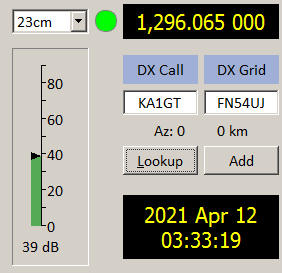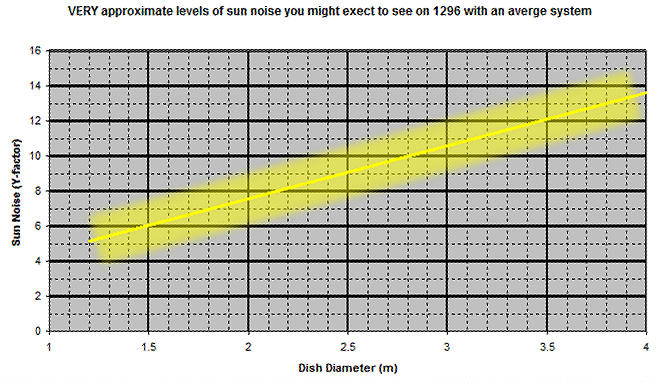Help - I can't find a signal. Diagnosing EME Rx
So you've built an EME system (and, as usual. I'll take 1296 MHz for my examples). but when you point the antenna at the moon you don't see or hear any EME signals. What's wrong and how do you diagnose the problems?
There are dozens of possible reasons why you are not hearing anything, so I'll go though the possibilities in some sort of logical order, probably covering amy things you will probably have already tried, but it doesn't hurt to cover all the bases.
It helps to be able to turn your preamp power on and off from the shack, and to be able to switch the preamp from the antenna to a 50ohm load from the shack. If you can't do either, then it will be difficult to do some of the basic tests. You need to be able to measure you noise level. The most basic and least accurate method is to look the Rx signal strength "thermometer" readout of WSJTX. That's on the left hand side of the main WSJTX window as shown below.

It only has 1dB resolution, but it's good enough for basic testing. You can also use the "measure" mode of WSJT10, which gives you 0.1dB resolution and a prints the audio level at 1 second intervals, or you can use something like SpectraVue for very accurate measuremenst which can be saves as files. But if all you have is WSJTX, that's fine to start with.
Note You can now use "echo" mode WSJTX v2.6.0 (and up), which will read out "Level" in dB with 0.1dB resolution and an integration time of about 3 seconds. This gives an excellent way to measure noise.

NOTE that for all noise tests (and pretty much anything else EME related) AGC must be OFF on your receiver. If you can't turn it off then you can't use audio noise levels for these tests.
- Point the antenna at the sky and look at the noise level with preamp (LNA) powered on and powered off. You should probably see something like 10dB or more noise change. If you don't you may have a problem. Too little gain in the preamp or too much loss in the cable connecting the preamp to the rest of the system.
- Point the antenna at the sky, well away from the sun. With the preamp on, switch the input to the preamp from the antenna to a 50ohms dummy load. On 1296 and up you should see the noise go UP when you switch to the 50ohm load. On 1296 I see about 8dB more noise from the 50ohm load then I do with the antenna looking at the cold sky. The lower your system noise figure, the bigger the difference will be. On 432 you will probably see a smaller change (since the sky is warmer) and on 144 you may see no change at all (or a slight decrease), depending on what part of the sky the antenna is looking at. If you are on 1296 or above and you don't see something like 6 to 8dB difference, you probably have a preamp, relay or cable problem.
- Sun noise. Point the antenna at cold sky, then point the antenna at the sun. Whatever band you are on you should see the noise level rise. How much it goes up depends on your antenna gain and your system noise figure. With a quiet sun, a 3m dish on 1296 should give you at least 9 or 10dB extra noise. Maybe 12dB if you have everything optimized. A 2m dish should give you around 9dB of sun noise if everything is well optimized, maybe 6 or 7dB if it's not. If you don't see sun noise either your Rx system isn't working or you aren't pointing at sun. For the active sun (2022 sun is active), these numbers can be 3dB higher. See sun noise and measuring sun noise.
- Sun noise should, of course, peak at the Az and El of the sun (given in the Astronomical Data window if WSJTX). If it doesn't then your az and El readouts aren't working, and if you can't find the sun using them, you won't be able to find the moon either!
- Note that these sun and 50ohm load tests are not sensitive to polarization. Reception of signles off the moon are not. On 1296 circular polarization is used. The standard convention for EME is to transmit in RHCP and receive LHCP. If you get these switched over and receive RHCP, you'll have maybe 15-20dB of polarization loss. That means you'll hear sun noise just fine, but you will only hear the very strongest EME signs. On 432 and 144. linear polarization is used and signals can come back with any linear polarization due to Faraday rotation. That means signals can fade quite a lot at times.
- Sun noise and 50ohm tests don't depend on you being on frequency. EME reception does, so make sure your radio is calibrated and you know where you are listening, compensating for the Doppler shift of the Dx station.
The main point here is that you can check your system out using noise tests before you start to listen for signals. If you can't pass the noise tests, you probably won't hear any signals. (Sun noise testing is especially useful since it tests the Rx system and noise figure as well as your antenna pointing accuracy (but it doesn't test you have the correct CP!). If you are seeing decent sun noise, you should be able to hear EME signals. You can calculate the exact amount of sun noise you should see if you know all your system parameters using a program like EMECalc, but below is a very rough estimate of how much sun noise you might expect with a typical system on 1296.

Again these are rough numbers. With my 3.1m dish (which is pretty well optimized for Rx) I would expect to see between 12.5 and 13dB with the quite sun (solar flux around 68). With an active sun (Solar flux up to maybe 140) you could see about 3dB more sun noise than is shown on this plot
If you are not seeing numbers somewhere around what the above chart would suggest, then you have to look for the cause. Possibilities include:
- A preamp which has a high noise figure - if the sky to ground or 50 ohm noise is low. Tune or replace preamp
- A preamp that's oscillating - Good preamps don't oscillate. RF absorbing foam inside the preamp case helps prevent oscillation.
- An isolation relay with high loss - remove it from the system and see if things get better. If they do, replace it.
- A connector or a cable with high loss between the dish and preamp or relay - try another cable
- A preamp with a good noise figure - but insufficient gain - You probably want a two stage preamp with >30dB gain
- A very lossy cable between the preamp and the shack - Try a different cable or check the connectors.
- A dish with a bad profile (unlikely at 1296) - you can try to measure and correct the profile.
- A feed that's not at the focal point of the dish - move it back and forth and see what the effect is on sun noise.
- You aren't pointing accurately at the sun - point accurately at the sun. If you can't find the sun, you certainly won't find the moon!
.jpg)